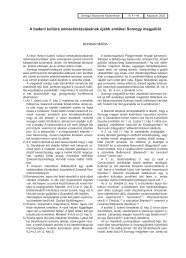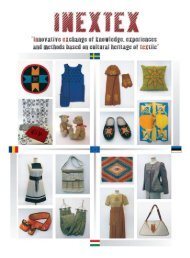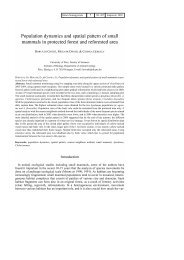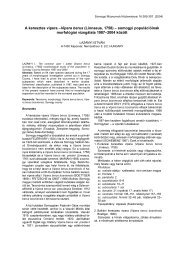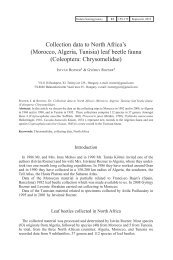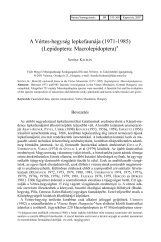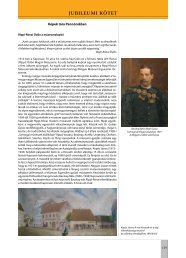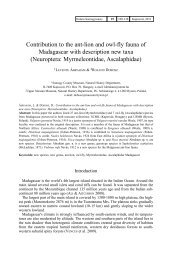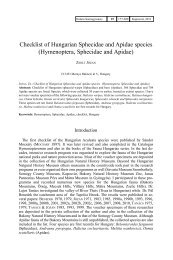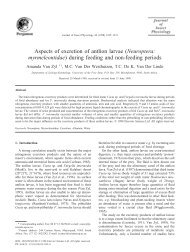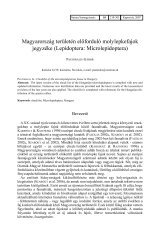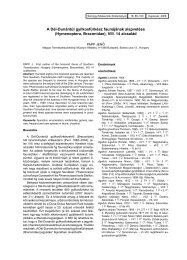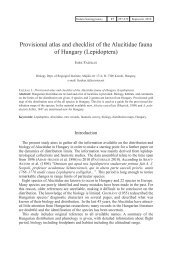Study on the Palaearctic Pristiphora species (Hymenoptera ...
Study on the Palaearctic Pristiphora species (Hymenoptera ...
Study on the Palaearctic Pristiphora species (Hymenoptera ...
You also want an ePaper? Increase the reach of your titles
YUMPU automatically turns print PDFs into web optimized ePapers that Google loves.
232<br />
NATURA SOMOGYIENSIS<br />
4. Mesopleur<strong>on</strong> light.....................................................................................................5.<br />
- Mesopleur<strong>on</strong> dark.......................................................................................................7.<br />
5. Sternites black. Labrum and legs pale yellowish brown. Pr<strong>on</strong>otal corners, tegula and<br />
mesopleur<strong>on</strong> brownish yellow. 4.5 mm. Sawsheath unknown. Known from a destroyed<br />
female specimen from Siberia. 4.5 mm...........................................P. flavipicta Lindqvist<br />
Siberia: Buryatskaya ASSR.<br />
- Sternites more or less light coloured.........................................................................6.<br />
6. Mesopleur<strong>on</strong> and also labrum, clypeus, pr<strong>on</strong>otum, tegula and abdominal sternites<br />
yellow. Claws almost bifurcate. Sawsheath like in Fig. 19. 4.5-5.0 mm.<br />
.......................................................................................................P. lanifica (Zaddach)<br />
Northwest Russia and Central and Nor<strong>the</strong>rn parts of Western Europe, Transylvania.<br />
- Black, light (light brown): labrum, lower margin of clypeus, corners of pr<strong>on</strong>otum,<br />
tegula, last tergites, abdominal sternites, mesopleur<strong>on</strong> and legs. Wings hyaline, venati<strong>on</strong><br />
brown, costa and stigma pale brown. Head finely and densely punctured, slightly shiny.<br />
Mes<strong>on</strong>otum anteriorly finely and densely punctured, nearly matt. Posterior part more<br />
shiny. Sawsheath in Fig. 19. Claw bifurcate. 4.5-5.0 mm..............P. variipes (Lindqvist)<br />
Finland and Northwest Russia.<br />
7.Small <strong>species</strong>, 3.0-4.5 mm. Sawsheath l<strong>on</strong>ger than cerci, or if not l<strong>on</strong>ger, antenna<br />
l<strong>on</strong>g and narrow, nearly as l<strong>on</strong>g as body (abdomen + half of <strong>the</strong> thorax).......................8.<br />
- Larger <strong>species</strong>, 4.5-7.0 mm. Antenna normal, sawsheath not projecting l<strong>on</strong>g bey<strong>on</strong>d<br />
cerci..................................................................................................................................9.<br />
8. Sawsheath l<strong>on</strong>ger than cerci and about twice as wide as a cercus. Labrum, hind corners<br />
of pr<strong>on</strong>otum, tegula and more or less abdominal apex yellow. Legs dominantly yellow.<br />
Antenna about as l<strong>on</strong>g or little l<strong>on</strong>ger than abdomen. 3.0-4.0 mm. [Apex of hind<br />
tibia and tarsus brown. Fr<strong>on</strong>tal area not clearly marked. Head with dense and fine punctures.<br />
Mes<strong>on</strong>otum finely punctured. Mesopleur<strong>on</strong> smooth and shiny. Claws with minute<br />
inner tooth. Wings hyaline, stigma yellow.].......................................P. retusa (Thoms<strong>on</strong>)<br />
Belgium, Switzerland, Germany, France, Northwest and Central Russia, Ukraine, Sweden, Scotland and<br />
Finland.<br />
- Yellowish brown or light brown: middle antennal segments below, a small triangular<br />
spot below <strong>the</strong> antenna, anterior margin of clypeus, labrum, hind corners of pr<strong>on</strong>otum,<br />
tegula, apical and lateral parts of abdominal segments, most of <strong>the</strong> femora, tibiae and<br />
tarsi. Wings hyaline, venati<strong>on</strong> brown, costa and stigma light brown. Antenna l<strong>on</strong>g, about<br />
as l<strong>on</strong>g as abdomen and half of <strong>the</strong> thorax toge<strong>the</strong>r. Sawsheath in Fig. 32. 4.8 mm.<br />
..............................................................................................P. tenuicornis (Lindqvist)<br />
Russia, Sweden, Finland and Korea.<br />
9. Hind femora entirely light coloured.......................................................................10.<br />
- Hind femora more or less darkened.........................................................................12.<br />
10. Sawsheath in Fig. 27. Abdomen <strong>on</strong>ly ventrally light coloured. Labrum and anterior<br />
margin of clypeus whitish. Mostly an upper orbital-spot, frequently <strong>the</strong> lower orbits<br />
or a spot between antenna yellowish. Pr<strong>on</strong>otum, tegula, more or less <strong>the</strong> sternites and<br />
mostly tergite 9 more or less yellow. Legs yellow, <strong>on</strong>ly bases of coxae black. Wings hyaline.<br />
Costa and stigma yellowish. 4.5-6.0 mm. Mesopleur<strong>on</strong> finely punctured, shiny.<br />
.......................................................................................................P. alpestris (K<strong>on</strong>ow)<br />
Belgium, Hungary, Switzerland, Slovakia, Germany, England, Karelia and Finland.<br />
- Sawsheath and colour different...............................................................................11.<br />
11. Sawsheath straight above and acute apically. Abdominal tergites, sternites and legs<br />
fulvous except <strong>the</strong> apex of middle tibia and <strong>the</strong> apical joints of middle tarsi. Tegula may<br />
be yellow. O<strong>the</strong>rwise entirely black. Wings infuscate. 5.0 mm......P. formosana Rohwer<br />
Known from Taiwan.



